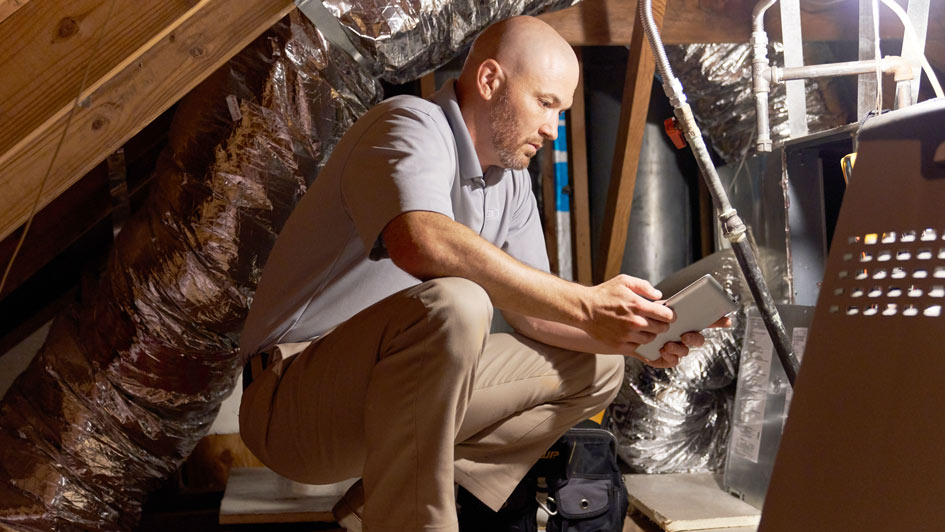
Did you know that more than 50% of your home’s energy costs are needed for your heating and cooling? That’s why it’s essential to maintain an energy-efficient HVAC system.
Furnace efficiency standards were last revised to an Annual Fuel Utilization Efficiency (AFUE) rating of 80% in 2015. This rating system measures how effective your furnace is at combusting natural gas into heat. An AFUE rating of 80% means your furnace wastes about 20% of the fuel it uses while creating heat.
In 2022, President Biden recommended new energy-efficiency standards for residential gas furnaces that would significantly reduce emissions, save consumers money and encourage sustainability.
This proposal is estimated to:
- Save Americans $1.9 billion annually.
- Lower carbon emissions by 373 million metric tons and methane emissions by 5.1 million tons over 30 years, the equivalent of what 61 million homes emit each year.
Starting in 2029, the updated rule would demand all new gas furnaces to feature AFUE ratings of 95%. This means furnaces would turn nearly 100% of the gas into usable heat.
Considering these guidelines, you might be asking yourself what does that mean for my existing furnace? As of now, not much, as the proposed rule will not go into effect until 2029 at the earliest and does not affect furnaces that are already in use.
But if you need furnace replacement in soon, highly energy-efficient furnaces are already available. Find out how these furnaces can help you save on energy bills now.
Guide to Condensing Furnaces
How Condensing Furnaces Work
A condensing furnace is a kind of heating system that uses a secondary heat exchanger to trap wasted heat from the furnace's exhaust gases. This limits the extent of energy wasted, increases energy efficiency and lowers CO2 emissions. It also involves less natural gas to create the same volume of heat when comparing one to other types of furnaces.
How Condensing Furnaces Differ from Non-Condensing Furnaces
The main difference between a condensing furnace and a non-condensing furnace is that the former uses a secondary heat exchanger to capture any wasted heat from its exhaust gases, while the other does not.
How Long Condensing Furnaces Last
The life span of a condensing furnace is dependent on the brand, model and other factors. Generally speaking, a condensing furnace should last between 10-20 years with appropriate maintenance and regular service. If your heating system doesn’t have regular furnace maintenance, the unit may struggle to perform as well, ultimately failing earlier than anticipated.
Why Condensing Furnaces Require a Higher Investment
For the most part, condensing furnaces are more require a large upfront cost than non-condensing furnaces. This is due to their increased efficiency and the additional features required to capture any wasted heat from its exhaust gases. However, the added energy savings can often cover the price of purchase. So long term, it may be more cost efficient to consider investing in a condensing furnace.
Guide to Variable-Speed Furnaces
Variable-Speed Furnaces: What They Are and How They Work
A variable-speed furnace can vary its fan speed to minimize the energy necessary to satisfy the heating needs of your home. It operates at a slower speed until it senses a drop in temperature and then ramps up to produce more heat. This [precise fan is significantly more efficient than standard, single-speed furnaces, as it only uses the minimum amount of energy necessary to heat your home, saving you money in the long run.
Most variable-speed furnaces are condensing furnaces, although a handful are available in non-condensing models with lower AFUE ratings. In order for a furnace to be classified as a condensing furnace, it must offer an AFUE rating of 90% or higher.
Do Variable-Speed Furnaces Run Nonstop?
A variable-speed furnace doesn’t need to stay on all the time. Rather, it runs at different speeds based on the temperature in your Perrysburg home as well as the amount of energy it uses to maintain that temperature.
When sufficient energy is necessary to maintain your desired temperature level, the furnace will shift to a higher speed in order to keep up with demand. Doing this will ensure more efficient heating in your home while also providing quieter operation.
Guide to Two-Stage Furnaces
Two-Stage Furnaces: What They Are and How They Work
A two-stage furnace is a type of heating system that utilizes two different stages of operation — high and low. When set to the low stage, the furnace performs at a reduced capacity in order to maintain the desired temperature at your home more efficiently. During the high stage, the furnace will instead run at maximum capacity to meet demands for more heat. With a two-stage furnace, you can enjoy greater energy efficiency and comfortable temperatures all across your home.
While two-stage furnaces are exceptionally efficient, not all all models are condensing furnaces.
Does a Two-Stage Furnace Function All the Time?
A two-stage furnace should not run constantly. In the low stage of operation, the furnace performs at reduced capacity in order to maintain a desired temperature more efficiently within your home. When a greater demand for energy is needed to maintain the set temperature, the unit switches to its high stage and operates at full capacity. Because of this, two-stage furnaces are able to help reduce energy costs without operating around the clock.
Contrasting Two-Stage and Variable-Speed Furnaces
Two-stage furnaces have two stages of functionality, low and high. During the low stage, the furnace performs at reduced capacity in order to uphold a desired level of comfort within your home. When additional warmth or cooling is necessary, the furnace will shift to its high stage and operate at maximum capacity.
Variable-speed furnaces, meanwhile, can function at several speeds in order to uphold a desired temperature more consistently at home. With more options for temperature settings, you also have more flexibility for heating you home and can enjoy greater savings on energy bills.
Differences Between One- and Two-Stage Furnaces
One-stage furnaces have a single stage fan speed and operate either at full capacity or not at all. As a result, the furnace is always running in order to maintain a desired level of comfort at home.
Conversely, two-stage furnaces have two stages of operation, low and high. While in the low stage, the furnace runs at lower capacity in order to maintain the desired temperature more efficiently. When additional warmth or cooling is needed, the furnace will change over to its high stage and operate at peak capacity.
Make Your Furnace Installation Appointment with Northwest Services Today
Modern furnace technology can be confusing. That’s why Northwest Services experts are here to help with a no-cost, no-pressure quote for furnace installation. We’ll assess your home, your heating needs and your budget before helping you find the ideal solution. Call us at 419-548-5017 to get started today!
